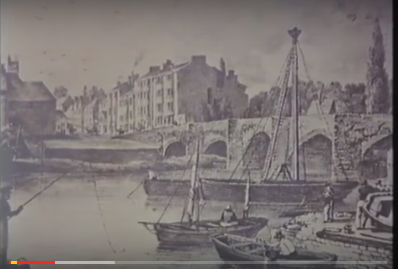
The Roman army reached Exeter around AD 50-
Medieval Exe Bridge
On a spur overlooking the River Exe a 42 acre legionary fortress was built.
This was the base for the 5000 strong Second Augustan Legion.
The fortress occupied a commanding position overlooking the River Exe, defended on two sides by steep valleys.
The defences and buildings of the fortress were constructed almost entirely from timber and clay.
The one exception was the bath house which had walls of volcanic stone quarried from Rougemont Hill.
It was an impressive building and was the equivalent to the modern sports hall.
Nothing was known of the bath-
It lay at a depth of up to 3m below the present surface of the Cathedral Close and was covered by Saxon and medieval cemeteries.
Following excavation the bath-
In about 75 the legion was transferred to Caerleon in South Wales and the fortress was abandoned.
A few years later work began to convert the site into a civilian town, known as Isca Dumnoniorum.{ The waters of dumnonia not exeter }
Its public buildings included a forum and basilica (town hall), a market place and public baths.
In about 180-
About two thirds of the City Wall remains; it has been patched and repaired over the centuries but some original Roman masonry can still be seen.
The sites of the gates were retained in the following centuries but little remains of the Roman grid street pattern.
Only the northern part of the High Street follows the Roman lines.
Displays of Roman finds from the city can be found in the Royal Albert Memorial Museum on Queen Street.
Roman Empire Roman Devon and Exeter 54 and 55BC Julius Caesar lands in Britain for first time but does not conquer 55BC Julius Caesar makes second visit to Britain. AD 41 Claudius becomes Emperor
AD 43 Roman Army invasion begins at Richborough in Kent
AD 44 or 45 Roman Legion II Augusta reaches Dorset
Iron Age people living and farming in Devon since around 700 BC. Dumnonii is the name given to people living in Devon and Cornwall by the Romans.
AD54 Emperor Claudius dies AD50-
About AD55 Roman Legion II Augusta build a fortress in Exeter
AD60 Boudicca, Queen of the Iceni tribe in the East of Britain, leads a revolt against the Romans. The Romans defeat her.
AD 60 Second Legion Augusta fail to provide help to other legions fighting Boudicca.
AD 116/7 The Roman Empire is at its biggest and best!
AD 122-
AD 75 Roman Legion II Augusta leaves Exeter . The Roman town, Isca Dumnoniorum starts to develop. AD 100 Exeter public baths built.
AD 198 soldiers allowed to marry whilst serving About AD 180’s/200’s Isca Dumnoniorum develops further with new stone walls– the ones you can see today AD 325 Christianity given legal status as religion of Roman Empire
AD337 onwards, rival Emperors fight for power, hostile tribes attack Roman frontiers
About AD 360 town starts to shrink
AD 410 no Roman legions left in Britain, About AD 410 town being abandoned AD 476 The Roman Empire falls when the last Emperor, Romulus Augustus resigns. About AD 450 town site is now a cemetery 5th century to 9th century just a few pottery sherds found. Town rubble either removed or overgrown and becomes new ground surface. 16th century to today, More and more thinking about whether the Romans came to Devon. First one or two finds, then in 20th century, first excavations. Fortress remains first discovered in 1971.

variously specified as Isca Augusta or Isca Silurum, was the site of a Roman legionary fortress and settlement or vicus, the remains of which lie beneath parts of the present-
The site includes Caerleon Amphitheatre and is protected by Cadw.
Headquarters of the Legion "II Augusta", which took part in the invasion under Emperor Claudius in 43, Isca is uniquely important for the study of the conquest, pacification and colonisation of Britannia by the Roman army.
It was one of only three permanent legionary fortresses in later Roman Britain and, unlike the other sites at Chester and York, its archaeological remains lie relatively undisturbed beneath fields and the town of Caerleon and provide a unique opportunity to study the Roman legions in Britain.
Excavations continue to unearth new discoveries, in the late 20th century a complex of very large monumental buildings outside the fortress between the River Usk and the amphitheatre was uncovered.
This new area of the canabae was previously unknown.
The Brythonic name Isca means "water" and refers to the waters
The suffix Augusta appears in the Ravenna Cosmography and was an honorific title taken from the legion stationed there.
The place is commonly referred to as Isca Silurum to differentiate it from Isca Dumnoniorum and because it lay in the territory of the Silures tribe. owever, there is no evidence that this form was used in Roman times. The later name, Caerleon, is derived from the Welsh for "fortress of the legion".













